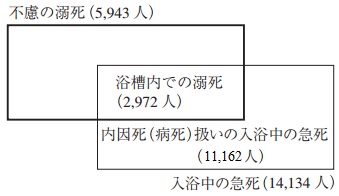 同じ状況で浴槽で急死した場合でも、医師によって事故死(外因死)と判断され「溺死」となったり、病死(内因死)と診たてられ、たとえば「心疾患」のなかにカウントされたりする。
同じ状況で浴槽で急死した場合でも、医師によって事故死(外因死)と判断され「溺死」となったり、病死(内因死)と診たてられ、たとえば「心疾患」のなかにカウントされたりする。
このことを事実をもとに推定しているのが、東京消防庁と東京都監察医務院による実態調査(1999年)である。これによると、入浴に起因した救急隊の出動では、疾病に起因する「急病」と分類されたものが「事故死」とされるものより多い。また「病死」扱いのものと「事故死(溺死)」扱いのものとを解剖して調べた結果、その両者に統計学的な相違はほとんど認められなかったという。したがって、浴槽での「溺死」という概念では、実態を必ずしも正確にとらえられず、「病死」に扱われるものも含めて「入浴中の急死」という概念でとらえるべきことを提起している。その概念で推定すると、1999年の全国の「入浴中の急死」数は、「浴槽内での溺死」(2,972人)の4.8倍に相当する1万4千人にもなるというのだ(図)。
住宅内の事故、とくに入浴中の事故を中心に
by 鈴木晃
http://www.niph.go.jp/soshiki/09seikatsu/arch/006.pdf
自殺者
24,025人
平成27年中における自殺の内訳
内閣府
http://www8.cao.go.jp/jisatsutaisaku/toukei/pdf/h27joukyou/s2.pdf
**
交通事故死
4,117人
交通事故死者数の推移
時事ドットコムニュース
http://www.jiji.com/jc/graphics?p=ve_soc_tyosa-jikokoutsu
Nicholas Kristof
https://kushima38.kagoyacloud.com/?p=47973
Are terrorists more of a threat than slippery bathtubs? 464 people drowned in America in tubs, sometimes after falls, in 2013, while 17 were killed here by terrorists in 2014.
The basic problem is this: The human brain evolved so that we systematically misjudge risks and how to respond to them.
Unfortunately, our brains are not well adapted to most of the biggest threats we actually face in the 21st century. Warn us that climate change is destroying our planet, and only a small part of our prefrontal cortex will glimmer; then we’ll go back to worrying about terrorists.
Our brains are perfectly evolved for the Pleistocene, but are not as well suited for the risks we face today.
(sk)
風呂場は戦場よりも怖い。
入浴はテロよりも危険だ。
入浴中に急死する人は、交通事故で死ぬ人よりはるかに多い。